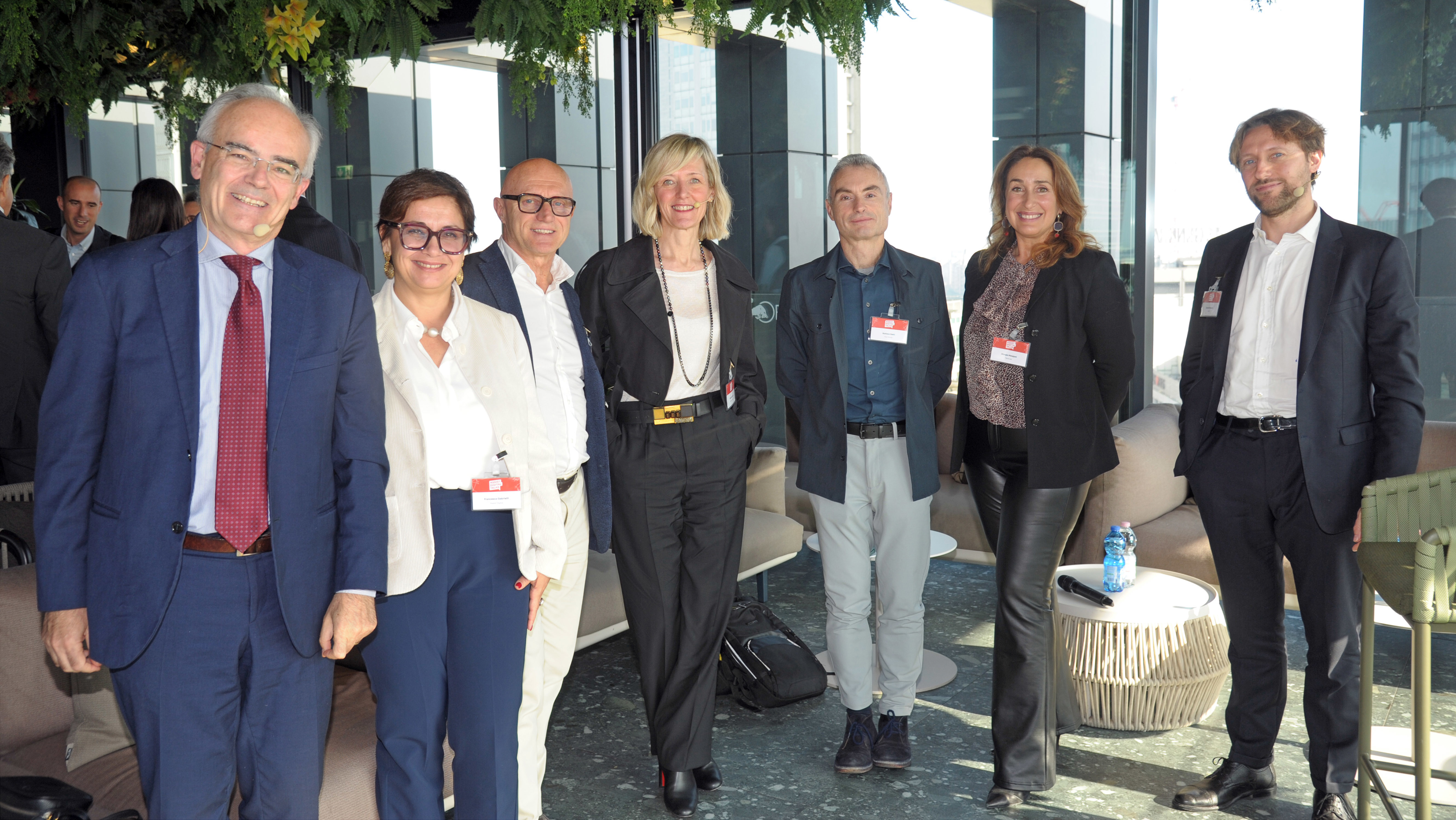Will GenAI be the engine of innovation?
Key insights from Prof. Andrea Bonaccorsi and industry leaders, at our Digital Talk event in Milan.

On November 16th, 2024, we hosted our second Digital Talks, featuring the renowed Italian economist Professor Andrea Bonaccorsi as the keynote speaker. In front of an audience of executives from top brands, the professor discussed the role of Generative AI as a driving force for innovation.
The session, introduced by our CEO Francesca Gabrielli and moderated by our Executive Chairman Enrico Donati, was enriched by the insights of distinguished panelists, including Monica Dalla Riva, SVP and Chief Design Officer at Deutsche Telekom AG, Stefano Gatti, Head of Data & Analytics at Nexi, Giorgia Molajoni, Chief Technology and Communication Officer at Plenitude, and Daniele Petecchi, Global Head of Data and Artificial Intelligence at Pirelli. The speakers shared their perspectives on leveraging AI to promote innovation in different sectors, and how their companies are tapping into AI’s vast potential to enhance existing processes and create new capabilities.
The evolution of AI: where do we stand today and where are we headed?
In the last ten years, according to the AI Index 2024 Annual Report, Artificial Intelligence has significantly accelerated, reaching linguistic and cognitive performance levels comparable to those of humans. Today, people primarily use GenAI for:
- Technical Assistance & Troubleshooting (23%)
- Content Creation & Editing (22%)
- Personal & Professional Support (17%)
- Learning & Education (15%)
- Creativity & Recreation (13%)
- Research, Analysis & Decision-Making (10%)
The operational areas most impacted by AI include: sales, marketing, software engineering, customer operations, and product research&development.
What is the road to Artificial General Intelligence (AGI)?
According to the CEO of OpenAI Sam Altman, within the next ten years, we will reach an even higher level of performance with Artificial General Intelligence. Google researchers describe AI's development across five distinct levels:
1° chatbots and AI with conversational language
2° reasoners, human level problem solving
3° agents, systems that can take actions
4° innovators, AI that can aid in invention
5° organizations, AI that can do the work of an organization

Five cognitive modalities of innovation
In his speech, Prof. Bonaccorsi explored five key cognitive modalities that underpin innovation processes and the role of GenAI in each of them:
1.Research
Innovation in research develops when: the objective is well-defined, the research space is finite, the research procedure is known, the success criterion is clear. However, the main challenge lies in the size of the space to explore. AI has already reached comparable or superior performance to humans in tasks such as medical diagnosis and information retrieval. However, AI systems are not yet able to autonomously explore complex spaces or fully handle causal reasoning effectively.
2. Recombination
Digital technology is a key enabler of recombination-based innovation, which involves combining physical components (e.g. the Guthenberg press) or previously separate functions (e.g. the smartphone, Netflix, Booking, Spotify, etc). AI supports divergent thinking - GenAI can draw an elephant whose ears look like butterfly wings - and explores unusual combinations. However, it is not capable of identifying radically new ideas.
3. Analogy
Innovation through analogy is based on identifying similarities between different domains of knowledge. For example, the idea for the Bialetti coffee pot comes from observing the traditional process of washing clothes in the river where water rises up with the washing ash. But the further apart these domains are, the more difficult the adaptation process becomes, and the higher the risk of errors. Although LLM systems can generate competitive analyses or business models for new entrepreneurial ideas, their ability to produce creative analogies is limited.
4. Negation
Innovation through negation involves removing essential components from a product or process, forcing the mind to think counterfactually. Examples of such innovation include Lego shifting from wooden to plastic toys because, after the war, it found itself without raw materials. So, it decided to try a new material - plastic. Another example is Ryanair's cost-cutting strategies to make air travel more accessible. However, GenAI has limitations when processing complex counterfactual thinking or "negating" key aspects of an experience.
5. Abstraction
Innovation through abstraction occurs when an innovator can see a solution in general terms, regardless of the specific context. For instance, Katalin Karikó’s vision of using mRNA for protein production and Polegato’s obsession with finding materials that would release moisture asymmetrically for Geox shoes are prime examples. While GenAI is powerful, it has limitations in forming robust abstractions and reasoning about concepts that have not been directly encountered in its training data.
The innovation process activates various cognitive mechanisms. These processes require advanced reasoning skills, including logical reasoning, causal reasoning, and abduction (reverse thinking). GenAI has demonstrated superhuman performance in information retrieval and is effective in generating new ideas through “creative recombination”. However, it has significant limitations in identifying productive analogies, handling negation, and performing abstract reasoning.

Accelerators for AI integration in business
The panelists highlighted the importance of an open approach to AI integration to maintain a competitive edge and discover new opportunities. This means investing in workforce development, supporting change management, and collaborating with educational institutions.
Above all, fostering opportunities for experimentation with AI across all levels and sectors is essential: becoming "prompt specialists" at all levels skilled in asking the right questions to AI and with AI and recognizing that mistakes are an integral part of learning and discovery.
Additionally, the debate identified some key accelerators for AI integration:
- Fostering diverse mindsets: engage both highly specialized experts and open-minded, experimental thinkers. Encourage individuals to use these tools freely within safe environments.
- Top management engagement: prioritize interventions by focusing on fewer, high-impact use cases to ensure clear, measurable results.
- Developing robust metrics: continuously refine the metrics for evaluating progress in AI integration, a crucial area that remains an open challenge.
- Address the critical role of regulation and the AI Act, leveraging our intellectual and business strengths despite having fewer resources than other countries.
In conclusion, the Digital Talk underscored AI’s transformative potential as a powerful driver of business innovation, while also highlighting the need for human oversight and strategic leadership to guide the necessary shifts in processes, skills, and corporate culture.
A new research agenda for management
To explore the combination between GenAI and innovation, business management should focus on key questions, such as:
- Are LLM systems correctly informed about business strategies?
- How do LLM systems reason about strategy and innovation topics
- What heuristics/cognitive processes do they use to solve strategy and innovation problems?
Research methodologies aim to develop a realistic benchmark through business case studies, using narrative features and systematic feature extraction to analyze LLM systems' behavior in the context of innovation.
Andrea Bonaccorsi Bio
Andrea Bonaccorsi is a renowned Italian economist and professor at the University of Pisa, specializing in the economics of innovation, science, and technology, with a particular focus on research and development policies. He has made significant contributions to understanding innovation dynamics and technology transfer, as well as policies to enhance scientific and industrial competitiveness at both the European and global levels. Bonaccorsi has also provided consultancy for national and international institutions, including the European Commission, and has published extensively on these topics.